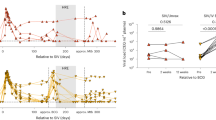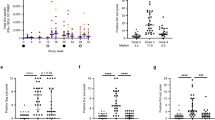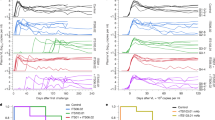Abstract
The impact of antigenic stimulation on the dynamics of simian immunodeficiency virus (SIV) replication was studied following repeated intravenous BCC inoculation of a SIV infected macaque. At the site of a delayed type hypersensitivity reaction to purified protein derivative of M. tuberculosis, a distinctive SIV variant was noted, probably as a result of the infiltration of activated antigen-specific T cell clones as opposed to infection by blood borne virus in situ. The dynamics of SIV quasispecies in peripheral blood suggests sequential waves of viral replication, illustrating the role of antigenic stimulation as a driving force in viral dissemination and pathogenesis.
This is a preview of subscription content, access via your institution
Access options
Subscribe to this journal
Receive 12 print issues and online access
$259.00 per year
only $21.58 per issue
Buy this article
- Purchase on SpringerLink
- Instant access to full article PDF
Prices may be subject to local taxes which are calculated during checkout
Similar content being viewed by others
References
Mcliroy, D. et al. Infection frequency of dendritic cells and CD4+ T lymphocytes in spleens of human immunodeficiency virus-positive patients. J. Virol. 69, 4737–4745 (1995).
Schnittman, S.M. et al. Preferential infection of CD4+ memory T cells by human immunodeficiency virus type 1: evidence for a role in the selective T-cell functional defects observed in infected individuals. Proc. Natl. Acad. Sci. USA 87, 6058–62 (1990).
Zack, J.A., et al. HIV-1 entry into quiescent primary lymphocytes: molecular analysis reveals a labile, latent viral structure. Cell 61, 213–222 (1990).
Gaynor, R.B. Regulation of HIV-1 gene expression by the transactivator protein. Curr. Top. Microbiol. Immunol. 193, 51–77 (1995).
Claydon, E.J., Bennett, J., Gor, D. & Forster, S.M. Transient elevation of serum HIV-1 antigen levels associated with intercurrent infection. AIDS 5, 113–114 (1991).
Fultz, P.N., Cluckman, J.C., Muchmore, E. & Girard, M. Transient increases in numbers of infectious cells in an HIV-1 infected chimpanzee following immune activation. AIDS Res. Hum. Retroviruses 8, 313–317 (1992).
Brichacek, B., Swindells, S., Janoff, E.N., Pirruccello, S. & Stevenson, M. Increased plasma human immunodeficiency virus type 1 burden following antigenic challenge with pneumococcal vaccine. J. Infect. Dis. 174,1191–9(1996).
Ho, D.D. HIV-1 viremia and influenza. Lancet 339, 1549 (1992).
O'Brien, W.A. et al. Human immunodeficiency virus type 1 replication can be increased in peripheral blood of seropositive patients after influenza vaccination. Blood 86, 1082–1089 (1995).
Stanley, S.K. et al. Effect of immunization with a common recall antigen on viral expression in patients infected with human immunodeficiency virus type 1. N. Engl. J. Med. 334, 1222–1230 (1996).
Staprans, S.I. et al. Activation of virus replication after vaccination of HIV-1 infected individuals. J. Exp. Med. 182, 1727–1737 (1995).
Cheynier, R. et al. HIV and T cell expansion in splenic white pulps is accompanied by infiltration of HIV-specific cytotoxic T lymphocytes. Cell 78, 373–387 (1994).
Levy, J.A. The value of primate models for studying human immunodeficiency virus pathogenesis. J. Med. Primatol. 25, 163–174 (1996).
Pelletier, E., Saurin, W., Cheynier, R., Letvin, N.L. & Wain-Hobson, S. The tempo and mode of SIV quasispecies development in vivo calls for massive viral replication and clearance. Virology 208, 644–652 (1995).
Wain-Hobson, S. Viral burden and AIDS. Nature 366, 22 (1993).
Burns, D.P.W. & Desrosiers, R.C. Selection of genetic variants of simian immunodeficiency virus in persistently infected rhesus monkeys. J. Virol. 65, 1843–1854 (1991).
Kuramoto, Y., Sekita, Y. & Tagami, H. Histoanalytical study of the cellular infiltrate in the tuberculin reaction. Clin. Exp. Dermatol. 18, 111–118 (1993).
Bleavins, M.R. & DelaIglesia, F.A. Cynomologous monkeys (Macaco fascicularis) in preclinical immune function safety testing: development of a delayed-type hyper-sensitivity procedure. Toxicology 95, 103–112 (1995).
Pilkington, C., Costello, A.M., Rook, C.A. & Stanford, J.L. Development of IgC responses to mycobacterial antigens. Arch. Dis. Child. 69, 644–9 (1993).
Rota, S., Beyazova, U., Karsligil, T. & Cevheroglu, C. Humoral immune response against antigen 60 in BCG-vaccinated infants. Eur. J. Epidemiol. 10, 713–718 (1994).
Chen, Z.W., Yamamoto, H., Watkins, D.I., Levinson, G. & Letvin, N.L. Predominant use of a T-cell receptor Vβ gene family in simian immunodeficiency virus gag-specific cytotoxic T lymphocytes in a rhesus monkey. J. Virol. 66, 3913–3917 (1992).
Chen, Z.W., Kou, Z.-C., Shen, L., Reimann, K.A. & Letvin, N.L. Conserved T-cell receptor repertoire in simian immunodeficiency virus-infected rhesus monkeys. J. Immunol. 151, 2177–2187 (1993).
Bandelt, H.J. & Dress, A.W.M. Split decomposition: a new and useful approach to phylogenetic analysis of distance data. Mol. Phylogenet. Evol. 1, 242–252 (1992).
Dopazo, J., Dress, A.W.M. & von Haeseler, A. Split decomposition: a new technique to analyse viral evolution. Proc. Natl. Acad. Sci. USA 90, 10320–10324 (1993).
Mansky, L.M. & Temin, H.M. Lower in vivo mutation rate of human immunodeficiency virus type 1 than that predicted from the fidelity of purified reverse transcriptase. J. Virol. 69, 5087–5094 (1995).
Ravn, P., Boesen, H., Pedersen, B.K. & Andersen, P. Human T cell responses induced by vaccination with Mycobacterium bovis Bacillus Calmette-Guérin. J. Virol. 158, 1949–1955 (1997).
Weissman, D., Barker, T.D. & Fauci, A.S. The efficiency of acute infection of CD4+ T cells is markedly enhanced in the setting of antigen-specific immune activation. J. Exp. Med. 183, 687–692 (1996).
Dittmer, U., Niblein, T., Meyerhans, A., Hunsmann, G. & Stahl-Henning, C. No reactivation of attenuated immunodeficiency viruses in macaques after vaccinia virus-induced immune activation. J. Cen. Virol. 78, 2523–2528 (1997).
Kreiss, J. et al. Association between cervical inflammation and cervical shedding of human immunodeficiency virus DNA. J. Infect. Dis. 170, 1597–1601 (1994).
Galai, N., Kalinkovich, A., Burstein, R., Vlahov, D. & Bentwich, Z. African HIV-1 subtype C and rate of progression among Ethiopian immigrants in Israel. Lancet 349, 180–181 (1997).
Bentwich, Z., Kalinkovich, A. & Weisman, Z. Immune activation is a dominant factor in the pathogenesis of African AIDS. Immunol. Today 16, 187–191 (1995).
Gerna, G. et al. Sharp drop in the prevelance of human cytomegalovirus leuko-DNAemia in HIV-infected patients following highly active antiretroviral therapy. AIDS 12, 118–119 (1998).
Chun, T.-W. et al. Quantitation of latent tissue reservoirs and total body viral load in HIV-1 infection. Nature 387, 183–188 (1997).
Finzi, D. et al. Identification of a reservoir for HIV-1 in patients on highly active antiretroviral therapy. Science 278, 1295–1300 (1997).
Perelson, A.S. et al. Decay characteristics of HIV-1 infected conpartments and implications for eradication. Nature 387,188–191 (1997).
Wong, J.K. et al. Recovery of replication-competent HIV despite prolonged suppression of plasma viremia. Science 278, 1291–1295 (1997).
Cheynier, R., Henrichwark, S. & Wain-Hobson, S. Sequence of the rhesus monkey T-cell receptor β chain diversity and joining loci. Immunogenet. 43, 83–87 (1996).
Cheng, S., Fockler, C., Barnes, W.M. & Higuchi, R. Effective amplification of long targets from cloned inserts and human genomic DNA. Proc. Natl. Acad. Sci. USA 91, 5695–5699 (1994).
Author information
Authors and Affiliations
Rights and permissions
About this article
Cite this article
Cheynier, R., Gratton, S., Halloran, M. et al. Antigenic stimulation by BCG vaccine as an in vivo driving force for SIV replication and dissemination. Nat Med 4, 421–427 (1998). https://doi.org/10.1038/nm0498-421
Received:
Accepted:
Issue date:
DOI: https://doi.org/10.1038/nm0498-421
This article is cited by
-
Pathogenesis of HIV infection: what the virus spares is as important as what it destroys
Nature Medicine (2006)
-
HIV preferentially infects HIV-specific CD4+ T cells
Nature (2002)
-
Ongoing HIV dissemination during HAART
Nature Medicine (1999)



